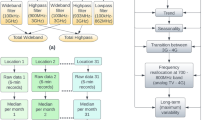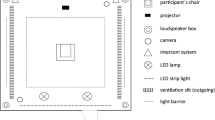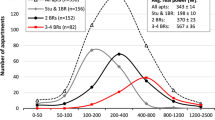Abstract
Between February and April 2003, a total of 80 single-dwelling households close (<70 m) to high-tension (161 or 345 kV) power lines in a northern community of Taiwan received measurements of indoor extremely low-frequency (ELF) magnetic field for 72 h. Measurements were performed with EMDEX II™ meter at a sampling rate of every 300 s, yielding some 860 readings of ELF magnetic field for each household. In addition to the 72-h mean ELF magnetic field, we also calculated arithmetic means of the first 2, 6, 12, and 288 readings taken in each household to represent the information on spot, 30-min, 60-min, and 24-h exposures, respectively. The mean 72-h exposure to ELF magnetic field for the 80 study households was estimated at 0.80 micro-Tesla (μT) with a standard deviation (SD) of 1.13 μT. The mean for pot, 30-min, 60-min, and 24-h exposure was 0.88 (SD 1.38), 0.90 (SD 1.40), 0.9 (SD 1.17), and 0.83 (SD 1.17) μT, respectively. There were high agreements, indicated by a nearly perfect intra-class correlation coefficient, between 72-h mean exposure and those short-term exposure measures. Additionally, the sensitivity and specificity of various short-term exposures in the prediction of 72-h exposure greater than 0.4 μT were similar at values of 0.82–0.87 and 0.93–0.95, respectively. This study indicates that short-term measurements of indoor ELF magnetic field seem adequate to represent the mean 72-h exposure, but tended to overpredict 72-h exposure greater than 0.4 μT. Further investigation is needed to assess whether these findings can be replicated in households far away from high-tension power lines.
This is a preview of subscription content, access via your institution
Access options
Subscribe to this journal
Receive 6 print issues and online access
$259.00 per year
only $43.17 per issue
Buy this article
- Purchase on Springer Link
- Instant access to full article PDF
Prices may be subject to local taxes which are calculated during checkout
Similar content being viewed by others
References
Ahlbom A., Day N., Feychting M., Roman E., Skinner J., Dockerty J., Linet M., McBride M., Michaellis J., Olsen J.H., Tynes T., and Verkasalo P.K. A pooled analysis of magnetic fields, childhood leukemia. Br J Cancer 2000: 83: 692–698.
Banks R.S., Thomas W., Mandel J.S., Kaune W.T., Wacholder S., Tarone R.E., and Linet M.S. Temporal trends, misclassification in residential 60 Hz magnetic filed measurements. Bioelectromagnetics 2002: 23: 196–205.
Blyth C., and Still H. Binomial confidence intervals. J Am Stat Assoc 1983: 78: 108–116.
Coghill R.W., Steward J., and Philips A. Extra low frequency electric and magnetic fields in the bedplace of children diagnosed with leukemia: a case–control study. Eur J Cancer Pre 1996: 5: 153–158.
Dockerty J.D., Elwood J.M., Skegg D.C., and Herbison G.P. Electromagnetic field exposures and childhood cancers in New Zealand. Cancer Causes Control 1998: 9: 299–309.
Eskelinen T., Niiranen J., and Juutilainen J. Use of short-term measurements for assessing temporal variability of residential magnetic field exposure. J Expo Anal Environ Epidemiol 2003: 13: 372–377.
Feychting M., Ahlbom A., and Kheifets L. EMF and health. Annu Rev Public Health 2005: 26: 165–189.
Feychting M., Kaune W.T., Savitz D.A., and Ahlbom A. Estimating exposure in studies of residential magnetic field and cancer: importance of short-term variability, time interval between diagnosis and measurement, and distance to power line. Epidemiology 1996: 7: 220–224.
Forssen U.M., Ahlbom A., and Feychting M. Relative contribution of residential and occupational magnetic filed exposure over twenty-four hours among people living close to and far from a power line. Bioelectromagnetics 2002: 23: 239–244.
Greenland S., Sheppard A.R., Kaune W.T., Poole C., and Kelsh M. A pooled analysis of magnetic fields, wire codes, and childhood leukemia. Epidemiology 2001: 11: 624–634.
IARC. Static and extremely low frequency electric and magnetic fields. IARC Monographs on the Evaluation of Carcinogenic Risks to Humans, Vol. 80, International Agency for Research on Cancer, Leon, 2001.
Kavet R., Ulrich R.M., Kaune W.T., Johnson G.B., and Powers T. Determinants of power-frequency magnetic fields in residences located away from overhead power lines. Bioelectromagnetics 1999: 20: 306–318.
Kleinerman R.A., Linet M.S., Hatch E.E., Wacholder S., Tarone R.E., and Severson R.K. Magnetic field exposure assessment in a case–control study of childhood leukemia. Epidemiology 1997: 8: 575–583.
Levallois P., Gauvin D., St-Laurent J., Gingras S., and Deadmen J.E. Electric and magnetic field exposures for people living near a 735-kilovolt power line. Environ Health Perspect 1995: 103: 832–837.
Li C.Y. Intensities and variation of in-home extreme low frequency magnetic fields in an urban sample of residences near high-voltage transmission lines. Fu-Jen J Med 2003: 1: 77–84.
Li C.Y., Chen P.C., Sung F.C., and Lin R.S. Residential exposure to power frequency magnetic field and sleep disorders among women in an urban community of northern Taiwan. Sleep 2002: 25: 428–432.
Li C.Y., Thriault G., and Lin R.S. A validity analysis of residential magnetic fields estimated from high-voltage transmission lines. J Expo Anal and Environ Epidemiol 1997: 7: 493–504.
Linet M.S., Hatch E.E., Kleinerman R.A., Robison L.L., Kaune W.T., Friedman D.R., Severson R.K., Haines C.M., Hartsock C.T., Niwa S., Wacholder S., and Tarone R.E. Residential exposure to magnetic fields and acute lymphoblastic leukemia in children. New Engl J Med 1997: 337: 1–7.
London S.J., Thomas D.C., Bowman J.D., Sovel E., Cheng T.-C., and Peter J.M. Exposure to residential electric and magnetic fields and risk of childhood leukemia. Am J Epidemiol 1991: 134: 923–937.
McBride M.L., Gallagher R.P., Theriault G., Armstrong B.G., Tamaro S., Spinelli J.J., Deadman J.E., Fincham S., Robson D., and Choi W. Power-frequency electric and magnetic fields and risk of childhood leukemia in Canada. Am J Epidemiol 1999: 149: 831–842.
Mezei G., Kheifets L.I., Nelson L.M., Mills K.M., Iriye R., and Kelsey J.L. Household appliances use and residential exposure to 60-Hz magnetic field. J Exp Anal Environ Epidemiol 2001: 11: 41–49.
Michaelis J., Schuz J., Meinert R., Zemann E., Grigat J.P., Kaatsch P., Kaletsch U., Miesner A., Brinkmann K., Kalkner W., and Karner H. Combined risk estimates for two German population-based case–control studies on residential magnetic fields and childhood acute leukemia. Epidemiology 1998: 9: 92–94.
Moriyama K., and Yoshitomi K. Apartment electrical wiring: a cause of extremely low frequency magnetic field exposure in residential areas. Bioelectromagnetics 2005: 26: 238–241.
Paniagua J.M., Jimenez A., Rufo M., and Antolin A. Exposure assessment of magnetic fields in urban environments in Extremadura (Spain). Bioelectromagnetics 2004: 25: 58–62.
Reitan J.B., Tynes T., Kvamshagen K.A., and Vistnes A.I. High-voltage overhead power lines in epidemiology — pattern of time variation in current load and magnetic fields. Bioelectromagnetics 1996: 17: 209–217.
Savitz D.A., Wachtel H., Barnes F.A., John E.M., and Tvrdik J.G. Case–control study of childhood cancer and exposure to 60 Hz magnetic fields. Am J Epidemiol 1988: 128: 21–38.
Thriault G., and Li C.Y. Risks of leukaemia among residents close to high voltage transmission lines. Occup Environ Med 1997: 54: 625–628.
Tomenius L. 50-Hz electromagnetic environment and the incidence of childhood tumors in Stockholm county. Bioelectromagnetics 1986: 7: 191–207.
Zaffanella L.E., Savtz D.A., Greenland S., and Ebi K.L. The residential case-specular method to study wire code, magnetic field, and disease. Epidemiology 1998: 9: 16–20.
Acknowledgements
The Taiwan National Scientific Council (NSC- 93-2320-B-030-006) financially supported this study
Author information
Authors and Affiliations
Corresponding author
Rights and permissions
About this article
Cite this article
Ger, WJ., Chang, W., Sung, FC. et al. Accuracy of short-term residential measurement in the prediction of 72-h exposure to power frequency magnetic field in households very close to high-tension transmission lines. J Expo Sci Environ Epidemiol 17, 69–75 (2007). https://doi.org/10.1038/sj.jes.7500522
Received:
Accepted:
Published:
Issue Date:
DOI: https://doi.org/10.1038/sj.jes.7500522
Keywords
This article is cited by
-
Does apartment’s distance to an in-built transformer room predict magnetic field exposure levels?
Journal of Exposure Science & Environmental Epidemiology (2013)



